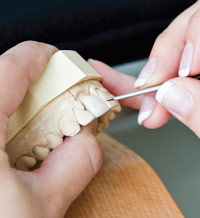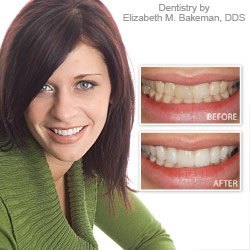Porcelain Veneers
Strength & Beauty As Never Before
(Continued)
Only An Artist Can Create Fine Art
Having the best paints, plaster, or pencils will help an artist create beautiful work. Talent and skill, however, count a whole lot more. It's the same with cosmetic dentistry. The best materials will only make a difference when employed by people who know what they're doing. So how do you know if a particular dentist is qualified to create the changes you seek? One surefire way is to check if they belong to an organization such as the American Academy of Cosmetic Dentistry (AACD) or the American Academy of Esthetic Dentistry (AAED). These organizations stress the importance of advanced education in cosmetic dentistry and their members have invested the time it takes to achieve the skill level necessary to work with today's high-tech materials and master the concepts of smile design. You should also ask to see before-and-after photos of work actually done by the dentist you are considering — not produced by third parties. A qualified cosmetic dentist should be proud to show these to you.
Finally, you should understand that the kind of skill required to produce the level of art necessary to make porcelain veneers look lifelike doesn't come at bargain basement prices. You are no doubt familiar with the saying “you get what you pay for.” Natural-looking, personalized, beautiful veneers don't come cheaply. Paying a little more up front tends to cost less in the long run, as your veneers will look better and last longer.
Crafting Veneers: A Material Advantage
When I first began working with veneers more than 20 years ago, the material of choice was feldspathic porcelain, which comes in a powdered form that is mixed with water to form a paste. Very skilled laboratory technicians use the paste to build the veneers up layer upon layer, curing or “firing” them in an oven. The final result mimics the translucency and color variations of a natural tooth.
Feldspathic porcelain is still used today, and it is very beautiful because it contains a high degree of silica, from which glass is made. It does, however, have a few disadvantages. Working with it is very labor-intensive and the material does have a tendency to shrink during firing. And some things that are built up in layers aren't as strong as when made in one piece.
 |
| Today's state-of-the-art material is lithium disilicate, a new stronger glass ceramic, which provides all the qualities needed in a veneer. |
To address these concerns, Leucite-reinforced ceramics were introduced in the 1990s. With Leucite ceramics, the bulk of the veneer could be fabricated in one piece by pressing molten ceramic into a mold, making the veneers significantly stronger and more exact. But still, there was a downside: they were a little thicker than feldspathic veneers and therefore could only be used in situations that allowed for the extra space they required.
Today's state-of-the-art material is lithium disilicate, a new stronger glass ceramic, which provides all the qualities needed in a veneer: strength, beauty, and ease of fabrication. In fact, lithium disilicate is double the strength of Leucite-reinforced ceramic. As such, it can be pressed even thinner — down to three tenths of a millimeter. That means lithium disilicate ceramic can be used in a broader spectrum of situations. Both Leucite-reinforced ceramics and lithium disilicate can be “pressed” or “milled” into shape, thereby increasing the accuracy of their fit. The veneers can then be reduced in size to accommodate additional layers of feldspathic porcelain for beautiful, lifelike results.
There are still indications for all of these materials. The choices depend on individual patient factors and requirements — such as strength, color change, and whether single or multiple veneers are needed. Dental laboratory technicians work hand in hand with your cosmetic dentist, who will have extensive consultations with you, the patient, about your aesthetic goals.
Raising the Curtain on a New You
If you have selected a qualified, experienced cosmetic dentist with whom you were able to communicate effectively, you will have — for a decade or more — a smile that appeals to all who see it, most especially you.
Maintaining your new veneers is easy but important. Normal gentle brushing and flossing are necessary to ensure good gum tissue health around them. Be careful to avoid using your teeth as tools (biting your nails, tearing open bags) or biting into very tough foods like candy apples or frozen candy bars. This can crack teeth, and also chip or crack veneers. And if you have a clenching or grinding habit, a custom-made night guard will be necessary to prevent putting excessive forces on the teeth. Regular checkups with your dentist will ensure your smile remains bright.
Throughout these pages you will find pictures of smiles enhanced with porcelain veneers. What you won't see is the reaction each person had upon seeing his or her new smile for the first time. It often is a very emotional experience for people to see themselves with a smile they never imagined was possible. And I love to hear stories from my patients about all the positive changes their new smiles are making in their lives. It's at that point I know we have succeeded in realizing the potential that was there all along.



